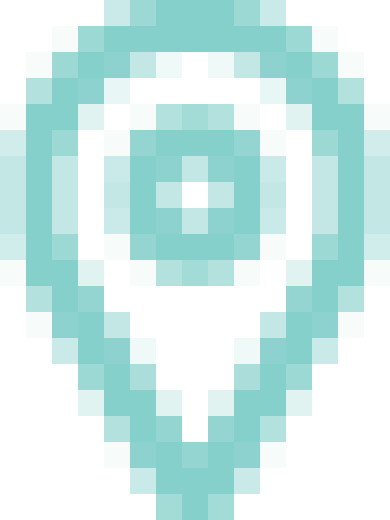Face Sculpting
and Contouring
A Guide to Cosmetic Face Sculpting: Cheeks, Chin, Jawline, Lips, Nose, Temples, Under-eyes
Facial Sculpting is an art form that allows our Vancouver EverYoung injectors in Port Coquitlam and Burnaby to achieve beautiful facial balance for our male and female patients.
It requires advanced injection techniques and precise placement of dermal fillers to improve facial proportions, create symmetry, and perfect individual features to achieve both balance and beauty.
It also addresses the signs of aging by correcting the downward lines associated with sagging skin—or to restore lost volume.
Non-Surgical Facial Contouring & Sculpting with dermal filler treatments is one of our most popular cosmetic treatments and provides instant gratification as results are immediate. Used in conjunction with botulinum toxin and other neuromodulators —a non-surgical facelift is achieved.
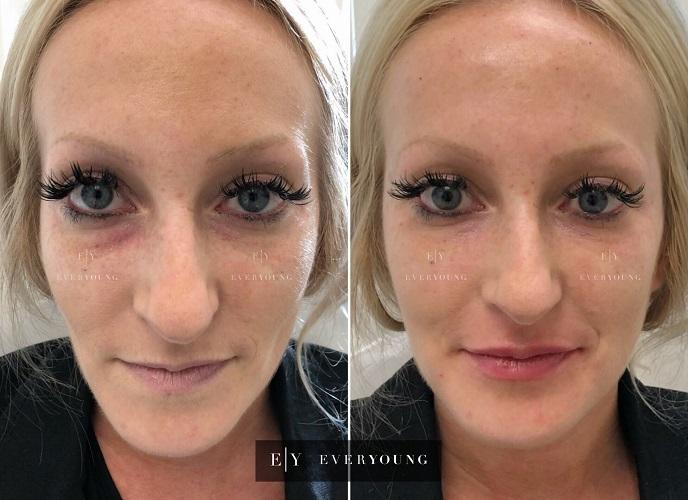
EverYoung patient / Combination Therapy: Under-eye, cheek, temple and lip correction
Cheek Augmentation & Enhancement in Vancouver
Not all of us are born with chiseled cheekbones—and if you desire a more pronounced or contoured cheek area—dermal fillers are used to achieve this. By adding volume to the area, we can rebalance the face and create a light-reflective, more angular, or contoured look. In the case of aging, you may have noticed sagging or deflation through your mid-face—resulting in less pronounced cheekbones.
Dermal fillers will replace the fat lost to the aging process to give you a healthier, fuller appearance. Filler in the cheek area also helps to give a “lift” to the lower face; softening nasal labial folds (smile lines) and jowls.
Chin and Jawline Shaping in Vancouver
Defining the chin and jawline
If you have a weak or undefined jawline, dermal fillers are used to add volume or chin projection for a more flattering view from both a front and side angle. The added volume won’t make you look heavy through the jaw or give you a double chin—but rather creates a more chiseled, angular, or defined jawline by building up the area for better overall facial features & proportions. This is a popular treatment for women who want a more sculpted or angular jawline—and for men who want a stronger profile.
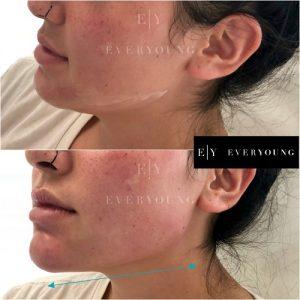
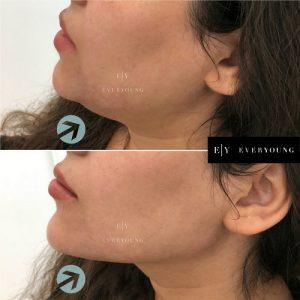
EverYoung patients / Jawline and chin shaping
Creating an oval-shaped face
Some patients have very strong masseter facial muscles (used for chewing), which gives them an overly wide jawline that can look masculine. By injecting botulinum toxin and other neuromodulators (we carry various well-known brands) into the muscle, our EverYoung doctors in North Vancouver, Burnaby, and Port Coquitlam can slim the jawline by relaxing the underlying muscle to create a more feminine, oval,light-reflective,mid-’20s, or heart-shaped face. Dermal filler may also be added to the chin area when projection is needed.
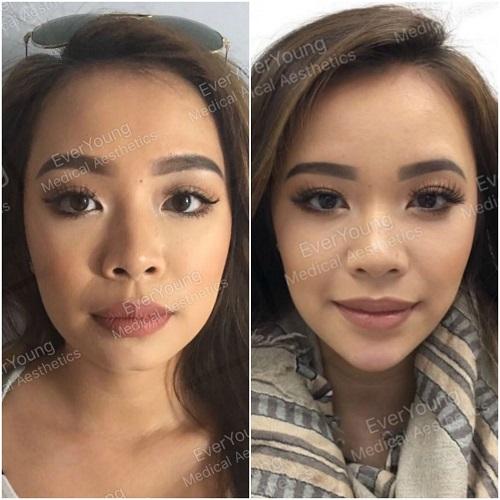
EverYoung Patient / Jawline slimming and chin enhancement for a heart-shaped face
Jowls and Jawline Softening
With age two things occur to the jawline. Firstly: As the skin loses elasticity and skin begins to sag, the jawline appears soft and lacks definition, and the corners of the mouth droop—forming wrinkles (marionette lines) that extend into the jawline creating jowls. Secondly: A loss of fat cells often causes two divots to form along the jawline known as pre-jowl sulcus, which further accentuates the appearance of jowls.
Dermal filler injections are used to fill in the lines, add volume where it has been lost, create a lifting effect, and camouflage the look of jowls with strategically placed filler. This procedure may also be combined with a skin tightening treatment.
- Fill in marionette lines with dermal filler
- If present—fill in divots with dermal filler
- Disguise jowls with strategically placed dermal filler
- Botox or Dermal fillers at the corners of the mouth will give a “lift” that counteracts the sagging
- Treating the mid area of the face (cheeks) also creates a lifting effect
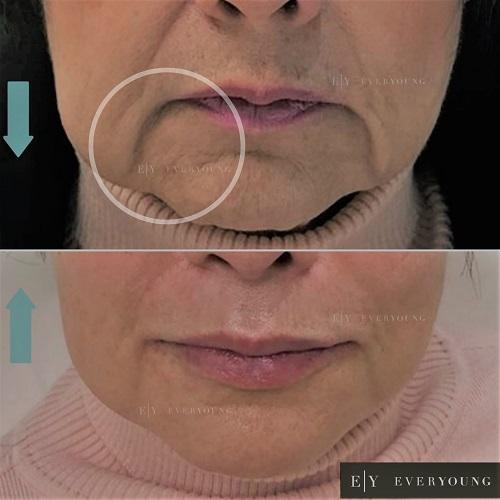
EverYoung patient / Cheek, jowls, jawline, chin dimpling and Lip Enhancement
Non-Surgical Nose job (Liquid Rhinoplasty) in Vancouver
One of our most dramatic treatments—a non-surgical nose job is used to make the nose appear slimmer, or to conceal a bump on the bridge of the nose.
Paradoxically by adding volume we can add light, making the nose look smaller and more even with carefully placed dermal fillers.
This is a non-invasive procedure that requires advanced anatomical knowledge. You are in good hands with our EverYoung injectors, who have all received advanced training in facial sculpting techniques to ensure a beautiful result without facial surgery.

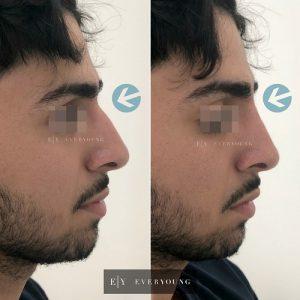
EverYoung Patients / Nose bump correction plus nose tip lifting in the second photo
Lip Enhancement in Vancouver
Lip injections are an art form in which the goal is to accentuate your lips while still maintaining overall balance. Whether your lips lend themselves to a keyhole pout or a balanced top and bottom depends upon your overall face shape and size. We listen to what you want to achieve and work with you to give you a result you are comfortable with—whether it is a mini lip, a natural lip, or something more dramatic. Lip plumping also smooths out dry lines and lip wrinkles for better lipstick application.
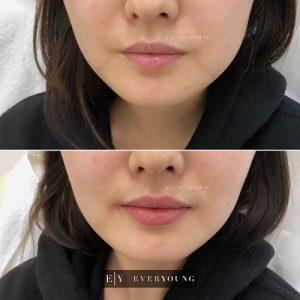

EverYoung patients/ Lip volume and lip line smoothing
Dark Circles and Under-Eye Treatment in Vancouver
Do people assume you are tired even when you’ve clocked a full eight hours? Your under-eye hollows may be to blame.
The skin below the eyes is very thin and one of the first areas to age. Along with wrinkles, some people are genetically predisposed to under-eye hollows. This ‘sunken’ area creates shadows and dark circles. Dermal filler is used to volumeize the area and create a smooth, light reflective surface that instantly refreshes your look. Dermal fillers also help conceal the underlying veins responsible for redness below the eyes.
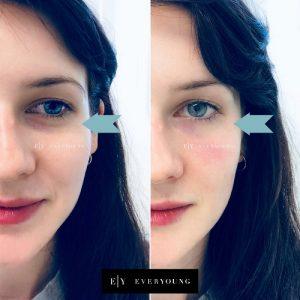

EverYoung patients following dark circle correction with under-eye filler
Temple Volume Replacement in Vancouver
One of the most telling signs of aging is volume loss in the temples. These hollows or indentations on the outermost area of the face create a ‘peanut’ shape—wide forehead, narrow temples and narrow cheeks. Temple hollows are caused by fat pad atrophy, but the loss of facial muscle, bone, and soft tissue may worsen the effect. The volume loss begins in the mid ’20s but accelerates in the ’40smid-’20s; progressively deepening over time.
The good news is that a dermal filler treatment restores volume to the area for a more youthful facial shape.
EverYoung patient / Temples, under-eyes, cheeks and lips
Our Patient’s Selfies Speak for Themselves!
The best recommendation comes from our EverYoung patients who have shared before and after photos of their aesthetic results. View them during your in-office consultation, on our website www.everyoungmed.com or via our Instagram account where our beautiful clients often tag us with their results.
Your RESULTS begin with a CONSULTATION!
604-942-8849
Email: info@everyoungmed.com
At EverYoung Medical Aesthetics, we carry every FDA-approved dermal filler (also known as wrinkle filler or soft tissue filler), available in Canada to provide you with the perfect product to obtain your desired results.
Juvederm / Juvederm Voluma XC / Juvederm Vobella / Juvederm Volift / Juvederm Ultra / Juvederm Ultra Plus / Radiesse / Teosyal / Teosyal PureSense redensity / Teosyal Ultra Deep / Teosyal Ultimate / Teosyal Kiss / Restylane / Restylane Fine lines / Perlane / Sculptra / BellaFill / Belkyra / Belotero / Belotero Hydro / Belotero soft / Belotero Balance / Belotero Intense / Belotero Volume / Belotero Ultra / Revanesse / Revanesse Contour / Revanesse Kiss / Revanesse Pure
FAQ
Progeria is a genetic condition that accelerates aging, resulting in distinctive facial features and changes in the overall shape of the face.
Contouring can change the appearance of your face by using makeup to highlight and shadow specific areas, enhancing features such as cheekbones and defining the overall facial structure.
Knowing the different shapes of the face is crucial for makeup application as it allows for tailored techniques that accentuate strengths and address unique features, creating a more harmonious and flattering overall look.
The purpose of contouring the face is to enhance facial features, create dimension, and define the bone structure by using makeup to highlight and shadow specific areas.
Facial contouring through makeup has no long-term physical effects but offers a transformative, temporary enhancement of facial features that can positively impact one’s appearance and confidence.
The benefits of skin contouring include enhanced facial definition, a more sculpted appearance, and the ability to highlight or downplay specific features for a desired makeup look.
Considering proper skincare before applying makeup is essential as it provides a smooth canvas, helps makeup adhere better, and contributes to a healthier complexion in the long run.
Considering head and face shapes and features before styling is crucial as it allows for personalized and flattering haircuts and hairstyles that complement and enhance individual facial characteristics.
Contour the areas of your face such as the hollows of the cheeks, jawline, sides of the nose, and the perimeter of the forehead to create dimension and enhance facial structure.
Yes, it is advisable to apply foundation before contouring as it provides a smooth base and ensures a seamless and blended finish for the contouring products.
Yes, contouring can significantly make a difference by enhancing facial features, creating dimension, and achieving a more sculpted and polished appearance.
Yes, applying foundation before contouring provides a uniform base, ensuring a natural and blended look for the contouring products.
Contouring is optional, and whether to contour your face depends on personal preference and desired makeup looks, as it can enhance features but is not necessary for every makeup application.
Facial contouring through makeup has no healing time as it is a temporary and non-invasive cosmetic technique with immediate results.
Contouring makeup typically lasts throughout the day, and its longevity depends on factors such as product quality, application technique, and individual skin type.
Face contouring with makeup is temporary and typically lasts until it is removed, offering a daily enhancement that can be adjusted based on personal preferences.
To effectively contour, understanding your face shape, choosing suitable products, and mastering blending techniques are essential for achieving a flattering and well-defined makeup look.
Contour your face as part of your makeup routine, adjusting the intensity based on the desired look, whether it’s a daily enhancement or a more dramatic, evening appearance.
Contouring results in a sculpted appearance, enhanced facial features, and a defined bone structure, providing a polished and dimensional look to the face.
The most important factor in applying makeup is understanding and catering to individual facial features and skin type to achieve a harmonious and flattering overall look.
There is no universally ideal facial shape, as beauty standards vary; however, the “oval” face shape is often considered versatile and well-balanced.
The oval face shape is considered suitable for most styles as its balanced proportions allow for versatility in various hairstyles and makeup looks.
Choose a contour shade that is a few shades darker than your natural skin tone to create a subtle shadow effect and enhance your facial features.
Yes, choosing the right contour shade depends on your skin tone, with individuals opting for cooler tones for fair skin, warmer tones for medium skin, and deeper shades for darker skin to ensure a natural and flattering effect.
Choose a contour shade that is a few shades darker than your natural skin tone with undertones matching your cool or warm undertones.
Your contour may not look good due to improper shade selection, insufficient blending, or using a formula that doesn’t suit your skin type.
Contouring with makeup can visually alter your face shape by enhancing or minimizing certain features through shading and highlighting.
While makeup techniques can create the illusion of a different face shape, naturally changing the bone structure of your face is not possible without surgical intervention.
The rule of contouring involves applying a darker shade to areas you want to recede and a lighter shade to areas you want to highlight, enhancing facial features and creating dimension.
The accurate method of contouring involves choosing the right shades for your skin tone, blending seamlessly, and applying contour strategically to enhance your natural features for a balanced and flattering look.
Contouring your face enhances facial features, adds dimension, and creates a more sculpted appearance, contributing to a polished and defined makeup look.
The purpose of contouring your face is to define and enhance your facial features by strategically shading and highlighting, creating a more sculpted and balanced appearance.
Contouring can change your face by accentuating or minimizing certain features through the strategic application of darker and lighter makeup shades, enhancing the perception of facial structure.
Facial contouring procedures can involve some discomfort, but the level of pain varies depending on the specific surgery or non-surgical technique used, and individual pain tolerance.
Contouring can visually alter the perception of face shape by strategically shading and highlighting, enhancing or minimizing certain features without changing the underlying bone structure.
Contouring can be done on mature skin, but it’s important to use a light hand, opt for cream-based products, and focus on subtle enhancements to avoid emphasizing fine lines and wrinkles.
Contouring can be challenging for beginners, but with practice, the right tools, and understanding your face shape, it becomes easier to achieve a natural and flattering result.
Contouring is a personal choice in makeup, and not everyone needs to contour; it depends on individual preferences and desired makeup looks.
The duration of face contouring depends on the products used, application technique, and factors like skin type and activity level. Generally, well-applied contouring can last throughout the day, but it may need touch-ups, especially in humid or active conditions.
Facial contouring procedures can involve varying degrees of discomfort, with surgical interventions typically causing more pain than non-surgical techniques, and individual pain tolerance playing a significant role.
Yes, you can contour on bare skin. However, using a primer or light moisturizer before contouring can help create a smoother base for better product application and blending.
Contouring can enhance facial features and create a more sculpted appearance, which some people find enhances their overall attractiveness; however, beauty standards and preferences vary among individuals.
Yes, face contouring can be an effective makeup technique for enhancing facial features, creating dimension, and achieving a more sculpted appearance when done correctly. The key lies in choosing the right shades, blending well, and applying makeup strategically to achieve the desired effect.
Yes, contouring can create the illusion of a slimmer face by strategically shading certain areas, such as the sides of the forehead, the hollows of the cheeks, and the jawline, while highlighting the center of the face. This technique adds dimension and enhances the perceived structure of the face.
Contouring methods include cream, powder, and stick contouring, targeting areas like the nose, jawline, and cheekbones; there are both makeup and surgical options for achieving different contouring effects.
Naturally changing face shape is limited to lifestyle factors like weight loss or gain, muscle development, and aging; for more dramatic changes, surgical interventions are required.
The color of contour matters as it should be a few shades darker than your natural skin tone, with consideration for undertones, to achieve a flattering and natural look.
Contour is typically a few shades darker than your natural skin tone to create depth and dimension.
For fair skin, choose a contour shade that is cool-toned and a few shades darker than your natural skin tone to achieve a subtle and natural look.
Contour is generally a few shades darker than your natural skin tone to create shadows and definition, but the key is subtlety for a natural appearance.
There isn’t a specific face shape that universally ages the best, as aging is influenced by various factors, including genetics, skincare, and lifestyle choices.

Results
4-6 Treatments

of Results
Months

None

Low

Time
30 Minutes

Work
Right away
Book an
Appointment

ALL SERVICES
- Acne treatment
- BBL- IPL Photofacial
- Body Fx
- Botox
- Coolsculpting
- Dermal Fillers
- Morpheus8
- Sylfirm X
- Sofwave
- Fotona StarWalker®
- Fractora
- Hair Loss / Balding
- Hydrafacial MD
- Laser Hair removal
- Alma Harmony® XL Pro
- Alma Harmony® XL Pro ClearLift™
- Alma Harmony® XL Pro Dye VL Laser
- Lip augmentation
- Laser Genesis
- Microdermabration
- Microneedling
- Non-surgical Facelift
- Pigmentation Treatment
- PDRN Salmon DNA
- Picosure
- Prp Blood Facial
- Red and vessels treatment
- RF Collagen Induction
- Ultherapy
- Thermage
- Thermage® CPT™
- Thermage® FLX
- Vaginal Rejuvenation
Where to Find Us?
Downtown Vancouver

MondayClosed
Tuesday10:00am–6pm
Wednesday10:00am–6pm
Thursday10:00pm–6pm
Friday10:00am–6pm
Saturday10:00am–6pm
SundayClosed
 604-706-1503 (English)
604-706-1503 (English) 604-305-2098 (Chinese)
604-305-2098 (Chinese)Metrotown, Burnaby

Monday10:00am–6pm
Tuesday10:00am–6pm
Wednesday10:00am–6pm
Thursday10:00pm–8pm
Friday10:00am–6pm
Saturday10:00am–6pm
Sunday10:00am–6pm
 604-305-2098 (English)
604-305-2098 (English) 604-305-2098 (Chinese)
604-305-2098 (Chinese)Free Parking Available
GET DIRECTIONSPort Coquitlam

Monday10:00am-6pm
Tuesday10:00am-6pm
Wednesday10:00am-6pm
Thursday10:00am-6pm
Friday10:00am-6pm
Saturday10:00am-6pm
SundayClosed
 604-210-6319 (English)
604-210-6319 (English) 604-305-2098 (Chinese)
604-305-2098 (Chinese)Free Parking Available
GET DIRECTIONSNorth Vancouver

MondayClosed
Tuesday10:00am–6pm
Wednesday10:00am–6pm
Thursday10:00pm–6pm
Friday10:00am–6pm
Saturday10:00am–6pm
SundayClosed
 604-265-7044 (English)
604-265-7044 (English) 604-305-2098 (Chinese)
604-305-2098 (Chinese)Free Parking Available
GET DIRECTIONSWith locations in Downtown Vancouver, North Vancouver, Burnaby & Port Coquitlam, we proudly serve people throughout greater Vancouver and the lower mainland with all of their acne, skin and beauty needs.
Contact us now to book an appointment.



